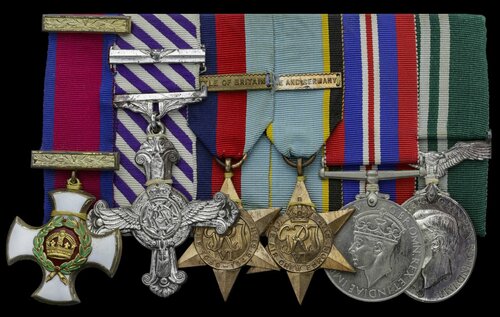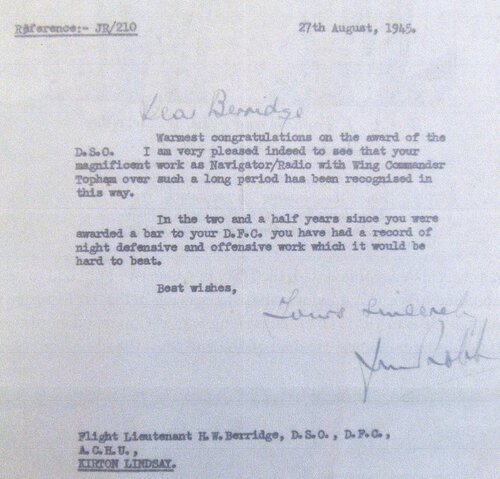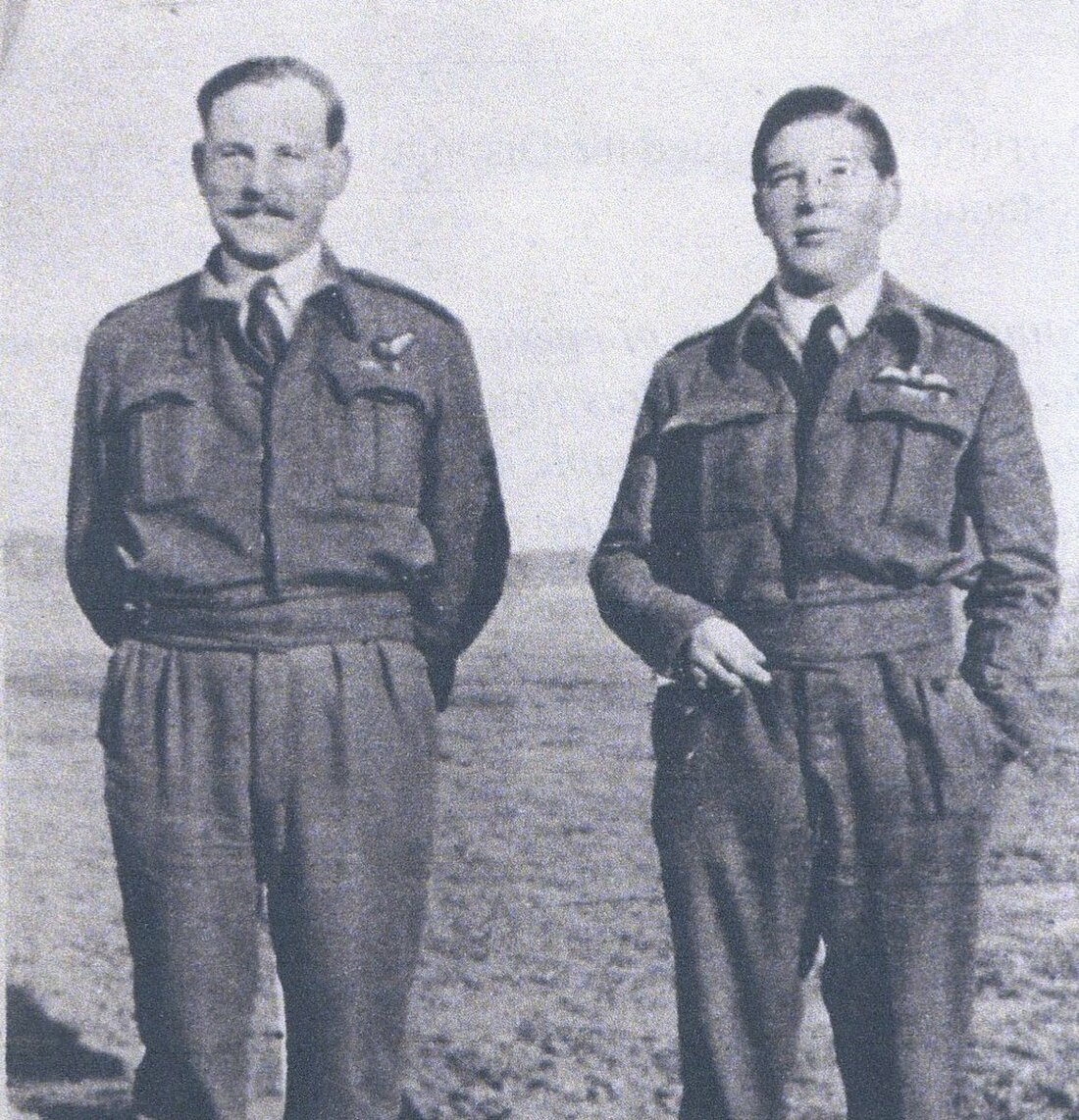Auction: 20003 - Orders, Decorations and Medals
Lot: 298
'Strewn across the Downs at the back of a South Coast town [Brighton] are bits and pieces of a German bomber. In the early hours of this morning [8 May 1942], the droning of heavy engines of the raider awakened the residents. Suddenly there came the sound of cannon fire - a night fighter had caught up with the intruder.
The raider was seen to burst into flames. As it lost height it broke into pieces, followed by a terrific explosion.
When I visited the scene this morning, writes an Evening Argus reporter, I saw the huge tail which had obviously been shot away by cannon fire. In a ploughed field I saw one of the engines. On a hill, a mile and a quarter away, pieces were being picked up.
The crew of the machine, numbering five, were all killed. When the main debris of the plane, which was buried in a crater, was examined in daylight, the mangled bodies of four of the airmen, burned and charred beyond recognition, were recovered. One of the uniforms was decorated with the Iron Cross first class and another with the Iron Cross second class … '
Luftwaffe Leutnant R. Oepen and his crew pay the ultimate price, having been tracked and traced by 'Johnny' Topham and 'Wilbur' Berridge in their Beaufighter of No. 219 Squadron; the front page of the Evening Argus, 8 May 1942, refers.
An exceptional Second World War night fighter's - and Battle of Britain veteran's - D.S.O., D.F.C. and Bar group of six awarded to Flight Lieutenant H. W. W. 'Wilbur' Berridge, Royal Air Force Volunteer Reserve
In one of the most successful partnerships of the war, as Observer / Navigator (Radio) to Wing Commander J. G. 'Johnny' Topham, D.S.O., D.F.C., he amassed a total of 13 confirmed victories, initially in Beaufighters of No. 219 Squadron and latterly in Mosquitos of No. 125 Squadron
Such notable success was achieved on the back of some hair-raising point-blank combats, thus the occasion on which their Beaufighter was turned upside down by the force of an exploding enemy aircraft
But whether their survival was attributable to Topham's lucky mascot - his German 'Mae West' removed from the wreckage of an earlier victim - remains open to debate. More likely it was down to Berridge's regular reminder to his pilot: "Remember, we don't want any ruddy damage to ourselves"
Distinguished Service Order, G.VI.R., silver-gilt and enamels, the reverse of the suspension bar officially dated '1945'; Distinguished Flying Cross, G.VI.R., with Second Award Bar, the reverses of the Cross and the Bar both officially dated '1942'; 1939-45 Star, clasp, Battle of Britain; Air Crew Europe Star, clasp, France and Germany; War Medal 1939-45; Air Efficiency Award, G.VI.R., 1st issue (Flt. Lt. H. Berridge, R.A.F.V.R.), good very fine and better (6)
D.S.O. London Gazette 17 August 1945. The original recommendation states:
'This officer has completed two tours of operational duty. Since the award of a Bar to the Distinguished Flying Cross, he has flown on a large number of operational sorties, in the course of which considerable damage has been inflicted on the enemy's mechanical transport. He has also destroyed four more enemy aircraft, bringing his total victories to at least 12 enemy aircraft destroyed and other damaged. Throughout his long operational career, Flight Lieutenant Berridge has displayed a fine fighting spirit, outstanding skill and a great devotion to duty.'
D.F.C. London Gazette 23 June 1942. The original recommendation states:
'This Observer has participated in many night fighting sorties against the enemy and has taken part in the destruction of 3 enemy aircraft. He has shown great skill and determination.'
Bar to D.F.C. London Gazette 20 October 1942. The original recommendation states:
'Flying Officer Berridge is a highly efficient Observer. He has at all times displayed great devotion to duty and set an example worthy of attainment. Since being awarded the Distinguished Flying Cross he has achieved much success.'
Horace Walter William Berridge, who was born in 1912 and raised in Sutton, Surrey, entered the printing trade on leaving school. But with the threat of hostilities looming on the horizon, he enlisted in the Royal Air Force Volunteer Reserve in April 1939.
Duly qualifying as an Air Gunner, he was posted to No. 219 Squadron, a Blenheim unit, and it was in this capacity that he flew his first operational sortie - out of Redhill - in the closing weeks of the Battle of Britain.
Night fighter - No. 219 Squadron
It was in the same month - October 1940 - that Berridge re-trained as a Radio Observer in the unit's newly delivered Beaufighters, prior to teaming-up with Flying Officer J. G. 'Johnny' Topham, the commencement of a highly successful partnership which would place them inside the top ten scoring night fighter crews of the war.
The Squadron having relocated to Tangmere, their first victory was obtained over Sussex on the night of 13-14 March 1941, when they engaged an enemy raider from 100 yards - incendiary and explosive ammunition hit its port engine and fuselage and it was seen to lose height over Bognor Regis. It was subsequently confirmed as an He. 111, as was their second victory achieved over Worthing on the night of 13 June 1941 - the latter was engaged at close range with 180 rounds of 20mm. and was seen to go down in a steep dive, emitting bright orange and green flashes; they also claimed a Ju. 88 damaged in the following month.
Front page news - the spectacular end of a raider over Brighton
On the night of 8 May 1942 - and Berridge having been commissioned in the interim - pilot and Observer claimed a spectacular victory over Brighton, as described above in a contemporary newspaper report.
Their victim, another He. 111, had taking evasive action over the course of long chase, but ultimately succumbed to numerous incendiary hits in the fuselage and port engine. It hurtled earthwards and crashed with 'terrific flash' at Patcham on the Downs. Bob Goodly, a constable in Brighton Borough Police, takes up the story:
'I was ordered to pick up Superintendent Gerald Crouch in the police incident van and go to the scene. We were the first there, it was a dark night with no moon, so it was difficult to get a clear picture of the wrecked aircraft. We checked the plane and found the pilot still in his seat, but his head had been blown off, leaving his ID tags still around his neck. I checked his pockets and found papers showing he was married and that he had previously been on the 'Baedeker Raids'. I have a recollection he was wearing an Iron Cross on his jacket. Only four bodies were found in the aircraft. A fifth was found at daybreak by Canadian soldiers on Sweet Hill, Patcham, just west of the A23.'
Further close encounters - D.F.C. - ace status
On the night of 8 June 1942, Berridge and Topham claimed a Ju. 88 over Bembridge on the Isle of Wight. Engaging their victim from 150 yards, Topham fired 286 rounds of 20mm. cannon and 455 rounds of .303 into the raider and obtained two perfect lines of strikes. It was seen to crash in the sea off Nettlestone Point, north of Bembridge but not before resultant debris inflicted damage on their Beaufighter, knocking Berridge off his seat. On landing back at Tangmere they found the underside of the fuselage and gun inspection panel had been ripped open.
Berridge was awarded the D.F.C. on 23 June and, just two weeks later, participated in the destruction of a Do. 217, this time operating out of Acklington. Closing to 250 yards, Topham unleashed 483 20mm. cannon and 1732 .303 rounds with devastating effect. The raider went into a steep dive and hit the sea with a bright orange-yellow flash, its demise being witnessed by members of a coastal battery at Amble.
Pilot and Observer were to achieve yet greater success on the night of 26 July, claiming two Do. 217's within seven minutes. The first encounter witnessed Topham's marksmanship removing the raider's tailplane but the second combat proved more challenging, the Dornier's dorsal gunner retuning fire as Topham closed the range. Not to be diverted from the job in hand, Topham delivered a telling attack from 200 yards and the raider turned to port with flaming debris dropping off its fuselage. It was seen to crash out to sea. During severe manoeuvring in this combat their Beaufighter's front hatch opened, thereby necessitating prompt action on Berridge's part, who climbed forward over the racks of ammunition to re-fasten the hatch.
'Blue riband' - B.B.C. - Bar to D.F.C.
News of Berridge's and Topham's ongoing success was now reaching a wider audience, one newspaper feature reporting that they had taken the 'blue riband' from John 'Cat's Eyes' Cunningham and his Observer, 'Jimmy' Rawnsley.
Indeed Topham was summoned to the BBC in London in late October, his subsequent interview referring in glowing terms to his partner in crime, 'Wilbur' Berridge:
'I might say all the advantages of night fighting are taken by the hunter, but there are rules. Don't let your quarry get sight of you first, quick and accurate fire, the first burst counts, try to take your victim by surprise. Only two enemy aircraft have ever managed to return fire on me, and in both cases they were damaged and going down. Always look for the darkest patch of the sky, it's important to keep clear of clouds that are lit up by the moon which may silhouette your aircraft. I've managed to shoot down three raiders in full moonlight, but it's the clear dark nights that I like best. Whenever I'm on patrol I feel like a boxer waiting for the gong to go, my knees are trembling, not through fear, but with excitement. You become part of the machine, by looking through the ring gunsight with the enemy aircraft under control. I quietly repeat the drill to myself, "Safety-catch released - everything under control - right, here we go." Then there is the rattle and roar of the engines, and the faint smell of cordite as the four cannon and six machine guns go into action.
My Observer, Berridge, says there is a time lag of one to two seconds before the act of firing and the contact of the bullets hitting the enemy. He glares at me and says, "Remember we don't want any damage to ourselves." By that he means I shouldn't get too close. Our Observers do a sterling job, and in particular mine. He has shared in 8 of my kills so far. He often pulls my leg by telling me "It's a hit or miss method." I remind him of our slickest kill when it was so dark you could only see the pinpoints of light coming from the exhausts, and I only used a 2 second burst to get him.
I remember a Heinkel we got over the south coast which literally lit up the sky in a fireball, and where you could clearly see the streets below. We also got two Dorniers within seven minutes of each other, the first one broke in half and did a vertical dive. I followed and at 2,000 feet saw a second one who started to take evasive action. We closed on him, giving him both cannon and machine gun fire. He made two slow rolls, exploded and fell into the sea in flames.'
It was also about this time that Topham revealed in a newspaper interview that he wore a macabre lucky mascot, namely a German 'Mae West' recovered from the wreckage of one of his victims.
Pilot and Observer were now approaching the end of their operational tour in 219 Squadron but by way of a parting shot they destroyed another Do. 217 on the night of 19 September 1943. It erupted into flamers after a six-second burst and was seen to crash in the sea off Tynemouth.
Berridge was awarded a Bar to this D.F.C. and, after a brief period of rest, returned to the fray with an appointment in No. 157 Squadron, a Mosquito unit operating out of Predannack. Employed on 'Ranger' sorties - and on occasion flying as Navigator to Wing Commander J. V. Wheeler, M.C., D.F.C. - he shared in the destruction of eight locomotives.
Renewal of the Topham-Berridge partnership - double figures and rising - D.S.O.
In October 1943, Topham, a recently promoted Wing Commander, assumed command of No. 125 (Newfoundland) Squadron, a Mosquito unit, and, at the request of his old partner in crime, happily enlisted Berridge as his new Navigator.
After a period of 'working up' the intrepid duo returned to the operational scene in convincing form in April 1944, taking out a Ju. 188 off St. Catherine's Point on the night of the 27th. Engaging the raider in his customary point-blank manner, Topham saw it break off in a steep dive, followed by a large explosion. Just two nights later, a Ju. 88 befell a similar fate, this time after a combat over the Solent.
On the night of 27 May 1944, pilot and Navigator fought a determined action against an Me. 410, their lengthy pursuit of their target taking them from Portland Bay to the Cherbourg Peninsula. Amidst return fire from the enemy aircraft, Topham delivered a three second burst from 200 yards and saw strikes on his adversary's fuselage and wing root. However, he broke off the attack after an 'audible banging noise' was heard coming from their Mosquito's fuselage.
Finally, on the night of 18 June 1944, Topham and Berridge took out a brace of Ju. 88s in a matter of minutes, this time over the Normandy beachhead. Such was Topham's marksmanship that he blew off the wing tip off one of them, whilst the second broke up into three pieces before plunging earthwards.
Their score now stood at 12 confirmed victories and Berridge, who had been advanced to Flight Lieutenant, was awarded the D.S.O. In writing to congratulate him on his award, Air Marshal Sir James Robb spoke of a record that 'would be hard to beat.'
Having finally been grounded in December 1944, he was released from the R.A.F.V.R. in late 1945.
Sold with the recipient's original Observer's and Air Gunner's Flying Log Book (Form 1267), covering the period 3 October to 11 December 1944, with signed endorsement, 'Certified that previous Log Book was lost in Squadron move'; together with congratulatory letter on the award of his D.S.O., from Air Marshal Sir James Robb, K.B.E., C.B., D.S.O., D.F.C., A.F.C., dated 27 August 1945 and a comprehensive file of research, including extensive post-war correspondence with those who served with Berridge.
Subject to 20% VAT on Buyer’s Premium. For more information please view Terms and Conditions for Buyers.
Sold for
£11,000
Starting price
£10000













